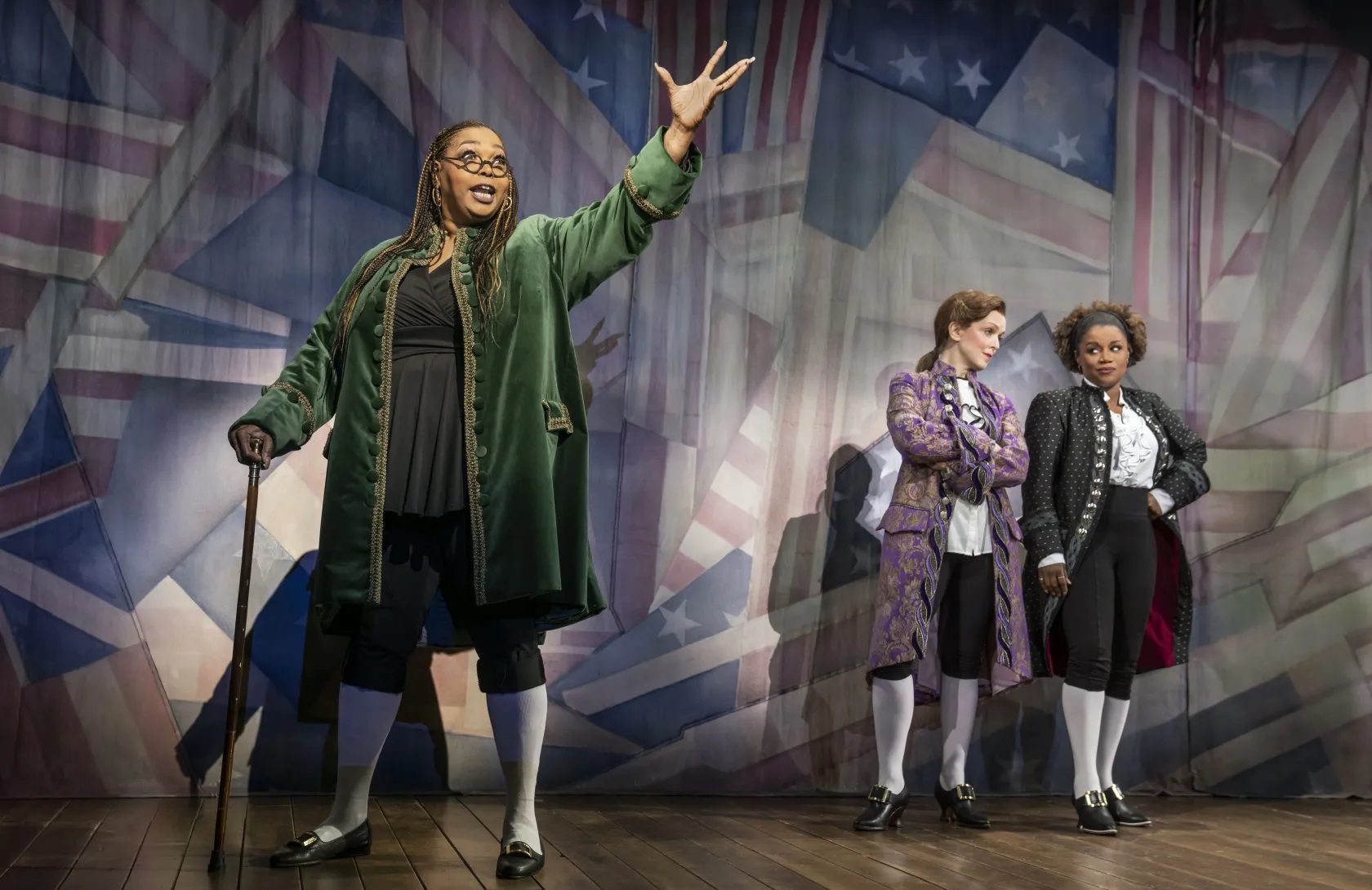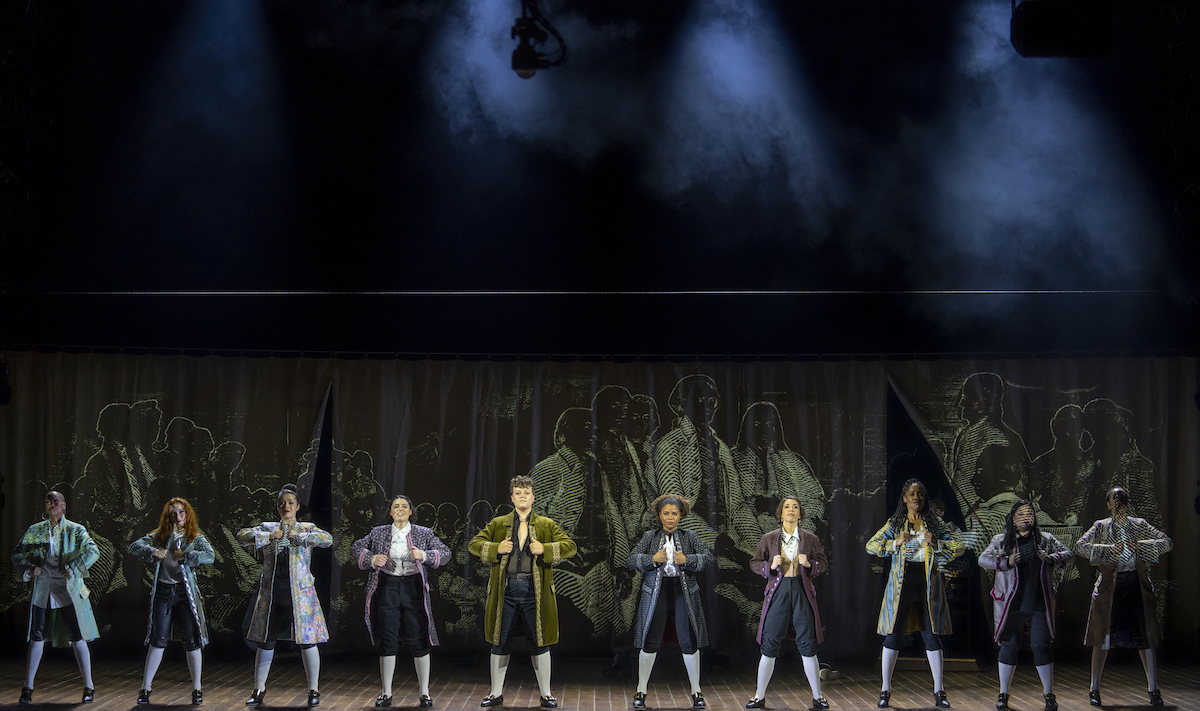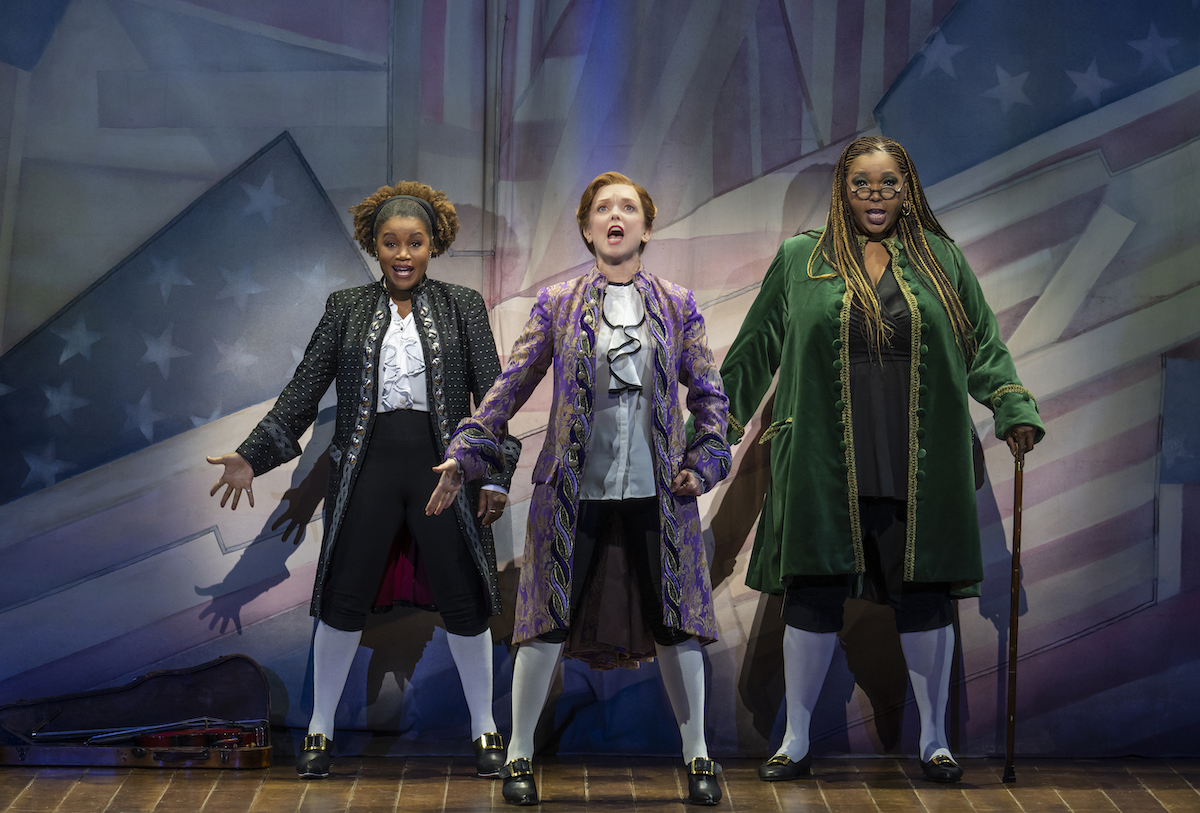A revival of the Tony-award winning 1776 with an untraditional cast arrives on its national tour with performances at the Ahmanson Theater through May 7. The historical musical follows America’s Founding Fathers during a sweltering Philadelphia summer when efforts led by Thomas Jefferson, Ben Franklin and John Adams massaged regional conflicts to crochet together compromises, some still toxic, to gain unanimous approval of the Declaration of Independence. Positive reviews from the national tour’s stop in Chicago found the current casting even better than some of the Broadway cast. Tickets on sale now.

The cast of 1776. Photo by Joan Marcus
In a recent phone interview, the revival’s choreographer and co-director Jeffrey L Page took time from current directing and lecturing duties in Philadelphia to talk about his move from choreographer to co-director, the decision to cast a racially and ethnically diverse group of women, trans, and nonbinary actors as those Founding Fathers, as well as how the events that severed the 13 colonies’ ties with England started a nation, left a lot of unfinished business that the country has yet to fully grapple with.

Jeffrey L. Page
Originally hired as associate director, a position that fine tunes but doesn’t participate in the creative decision making, Page’s wide-ranging background led to more creative responsibilities. His theatrical credentials as a dancer include the original Broadway cast of Fela, as a choreographer include the Broadway musical Violet with Sutton Foster, and as director include the musical Memphis in Japan. Page also has his foot firmly in the music world working with Beyoncé, Mariah Carey, and Jazmine Sullivan. The director Diane Paulus soon added choreographer to Page’s duties, then his creative contributions led Paulus to ask Page to step up as a co-director. He agreed. They set to work in what Page described as a blend of cultural perspectives.
“With me as a Black man and Diane as a woman of Japanese descent, we had different views but found we worked in a harmonious way.” Page said.

Diane Paulus and Jeffrey L. Page, co-directors of “1776.” Photo courtesy of the artists
Both directors brought fresh eyes to the fifty year old show.
When she was asked to consider directing a new production of 1776, she was unfamiliar with the musical, but curious, as she explained in a 2022 interview with the The Observer:
“I had done a revival of Hair on Broadway and knew that 1776 won over Hair for the 1969 Tony award for best musical. When I read 1776, I read it with the knowledge that the producers were willing to embrace non-traditional casting. I was thinking about that approach, and I was knocked out of my chair with how relevant the words were, how powerful this subject matter was. Immediately, I felt that this should be revived.”

Liz Mikel as Benjamin Franklin, Nancy Anderson as Thomas Jefferson and Gisela Adisa as John Adams in “1776.” Photo by Joan Marcus
Page admits he also had no clue about 1776 when asked to join the project. Page had not been born when the original 1776 was on Broadway in 1969. The show has had few revivals and Page had not encountered the 1972 film version. As he studied the musical and the underlying history, he agreed with Paulus’ insights about the musical’s powerful and current relevance. First as choreographer and then as co-director, Page’s efforts were aimed at developing that contemporary perspective.
“The founding of America was very different for Black people than the story the musical told. Once I started researching the musical and the events, I was interested in bringing my perspective to the table. The casting carries a different kind of commentary on where we came from as a country. Diane had already settled on the untraditional casting and we were both committed to finding the biggest and most fearless imagining of 1776,” Page recalled. “Diane set the direction we took. I brought the why and the how to make clear the framing of the story with this particular cast. Representation is important. If we don’t understand how we fit into society, we don’t understand or have a positive inclination to engage with society.”
In the 1972 film, the final scene is the assembled white men of privilege signing the Declaration of Independence, the final pose dissolving into the iconic painting by John Trumbull.

The signing of the Declaration of Independence. Painting by John Trumbull
Page was struck by those who were missing from the painting. “The painting feeds into a persistent narrative in billboards, artwork, and commercials that carry the message that this is America beautiful and intelligent, and if you don’t look like this then you are not in America, not really part of America.”
From Page’s perspective the untraditional gender casting with diverse races and ethnicities follows in the footsteps of musical Hamilton. “The casting underscores how slavery was at least on the table, but also how women and their rights were not even in the room. The casting also is a reminder how many in America don’t look like the people in the painting.”
Page admits the untraditional cast asks an audience to join the cast of 27 women, trans, and non-binary actors of diverse race and ethnicity on a journey that evokes Benjamin Franklin, Thomas Jefferson, John Adams, and those other Founding Fathers before they became statues on pedestals. Page eases the audience’s first steps on that journey with his choreographed opening where the cast literally step into the shoes of the Founding Fathers
Before the orchestra plays the first note, Page uses movement to acclimate the 21st century audience both to the world of 1776 and the untraditional casting. The actors in contemporary street clothes stroll onstage in recognizably contemporary movements. Then the actors begin to pick up and don late 18th century shoes, wigs, breeches, and other clothing. The choreographed transition is gradual as the actors begin to move in the more formal manner of the period until the moment when the cast is what the choreographer describes as “embodying” their character as well as their costumes. In front of the audience, the actors become the movers and shakers of the 13 colonies at the 2nd Continental Congress and the audience meets them before they are founding fathers of anything except extended arguments and in agreement on few things beyond John Adams’ incessant calls for a Declaration of Independence are annoying and General George Washington is whining in his dispatches pleading for military arms and supplies.

The National Tour Cast of “1776.” Photo by Joan Marcus
Page describes his goal from that choreographed start to the finish of the show, was to have the show’s narrative carried inside of the actors’ bodies.
“As a choreographer and a black man, my legacy lives in my body in the way I walk, talk, move, dance. In the opening I was thinking about Bertoldt Brecht’s concept of “gestus” that combined the concepts of gesture and social meaning. In order to build a character, the first thing is to embody the character. Gesture and choreography have a blurred line meaning if I can embody, I can move, speak and act as the character,” Page explained.

Liz Mikel as Benjamin Franklin in “1776.” Photo by Joan Marcus
“Allowing the audience to see how the actors’ posture and body movement evolves as they embody the character during the opening, starts to build a narrative that allows the inside to become legible in the body in moments that are not traditionally choreographed but seamless woven into the spoken text and the musical language.
After the Broadway opening in 2022, reviewers praised the choreographed opening but discussion of the casting and show’s emphasis on the compromise on slavery dominated reviews. Page acknowledges that some reviewers were surprised to realize that the 1969 musical had slavery in center of the play.

Gisela Adisa as John Adams, Nancy Anderson as Thomas Jefferson, and Liz Mikel as Benjamin Franklin in “1776.” Photo by Joan Marcus
“When it opened in 1969 during the Vietnam War, the show was reviewed as a metaphor for that war and to ignite us to be better human beings,” Page explained. “Reviews at that time rarely mentioned that in resolving the economic, social and political conflicts, the final compromise on slavery, the lynchpin that finally garnered unanimous approval of the Declaration of Independence, also embedded slavery as a foundational institution of this country. These were men trying to make a new world, fallible and with all the stuff that makes them human, but as a country we are still living with the consequences,” Page contended.
Originally scheduled for a mid-2020 opening, the show was among the many put on hold during the Covid-19 shutdowns. Events during the two year pandemic delay including the death of George Floyd, became part of the directors’ thinking about the revival.
“We have to reckon with the things that have been done or we’ll never move forward,” Page concluded.
For more information and to purchase tickets, please click HERE.
For more information about the Center Theatre Group and the Ahmanson Theatre, please visit their website.
Written by Ann Haskins for LA Dance Chronicle.
Featured Image: Gisela Adisa as John Adams in “1776” – Photo by Joan Marcus







